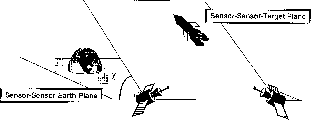




Next: Track Initialization
Up: 18.4.4 Two-dimensional Mono Tracking
Previous: Two-dimensional Track Extensions
The report formation subtask of the two-dimensional tracker
collects/organizes established two-dimensional tracks into a list to be
used as input for three-dimensional track initiations, where
``established'' simply means tracks older than some minimum cutoff age
(typically seven hits). The task of initiating three-dimensional
tracks from lists of two-dimensional tracks consists of two parts:
- Determining which items from the two lists are to be associated.
- Constructing three-dimensional state information for associated pairs.
The second task is straightforward geometry. The report function for two-dimensional
tracking is intended to aid in the more difficult association task.
The essential element in  associations is the
so-called hinge angle illustrated in Figure 18.19.
Consider a single target viewed simultaneously by two different
sensors. Assuming that each two-dimensional tracker knows the orbits of the other
tracker's sensor, each tracker can independently reconstruct two reference
planes in three-dimensional inertial space:
associations is the
so-called hinge angle illustrated in Figure 18.19.
Consider a single target viewed simultaneously by two different
sensors. Assuming that each two-dimensional tracker knows the orbits of the other
tracker's sensor, each tracker can independently reconstruct two reference
planes in three-dimensional inertial space:
- SSE:
- The plane containing the two sensors and the center of the earth.
- SST:
- The plane containing the two sensors and the target.
The hinge angle

is simply the angle between these two planes.

Figure 18.19: Definition of the Stereo Association Angle 
Once the time for the two-dimensional report has been specified, the
steps involved in the report function are relatively straightforward:
- Select all tracks satisfying the minimum age requirement.
- Use the state model in Equation 18.6 to propagate these
tracks to the reference time
- Evaluate both
 and its time derivative
and its time derivative  at the
reference time
at the
reference time
- Sort the list of reported tracks by
 values.
values.
The state model in Equation 18.6 not only provides the mechanism
for synchronizing the report items but also the additional variable
 , which ultimately aids in the associations of report lists from
two two-dimensional systems.
, which ultimately aids in the associations of report lists from
two two-dimensional systems.





Next: Track Initialization
Up: 18.4.4 Two-dimensional Mono Tracking
Previous: Two-dimensional Track Extensions
Guy Robinson
Wed Mar 1 10:19:35 EST 1995
 associations is the
so-called hinge angle illustrated in Figure 18.19.
Consider a single target viewed simultaneously by two different
sensors. Assuming that each two-dimensional tracker knows the orbits of the other
tracker's sensor, each tracker can independently reconstruct two reference
planes in three-dimensional inertial space:
associations is the
so-called hinge angle illustrated in Figure 18.19.
Consider a single target viewed simultaneously by two different
sensors. Assuming that each two-dimensional tracker knows the orbits of the other
tracker's sensor, each tracker can independently reconstruct two reference
planes in three-dimensional inertial space:








 and its time derivative
and its time derivative  at the
reference time
at the
reference time
 values.
values.
 , which ultimately aids in the associations of report lists from
two two-dimensional systems.
, which ultimately aids in the associations of report lists from
two two-dimensional systems.